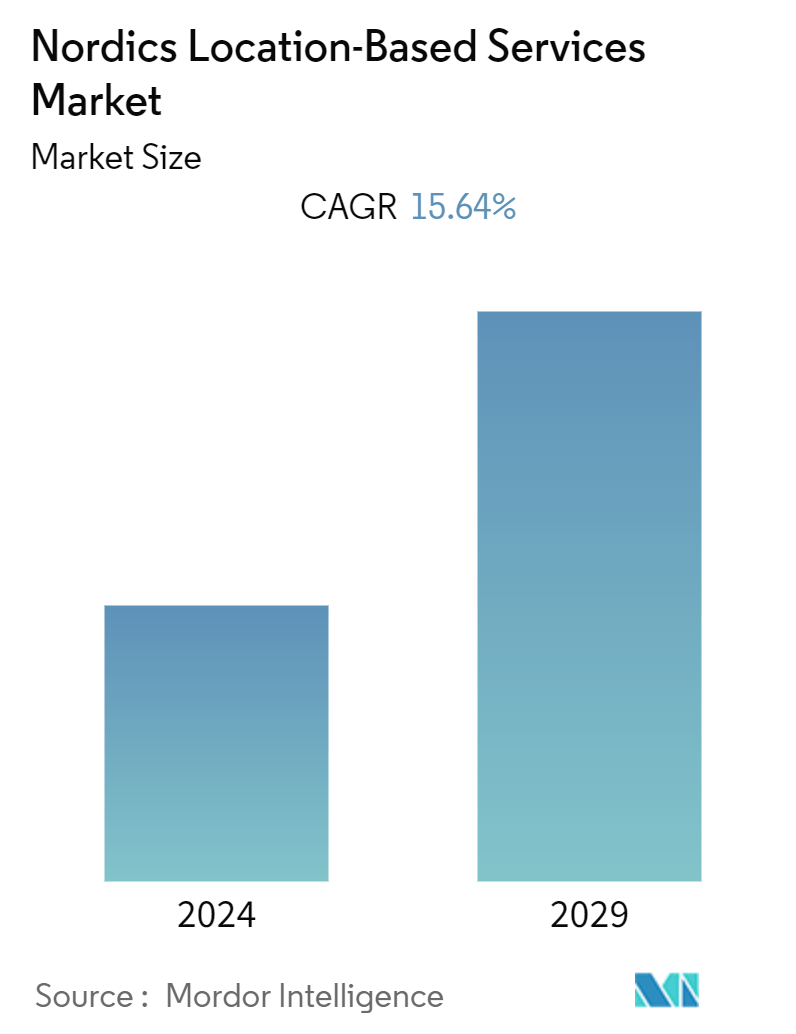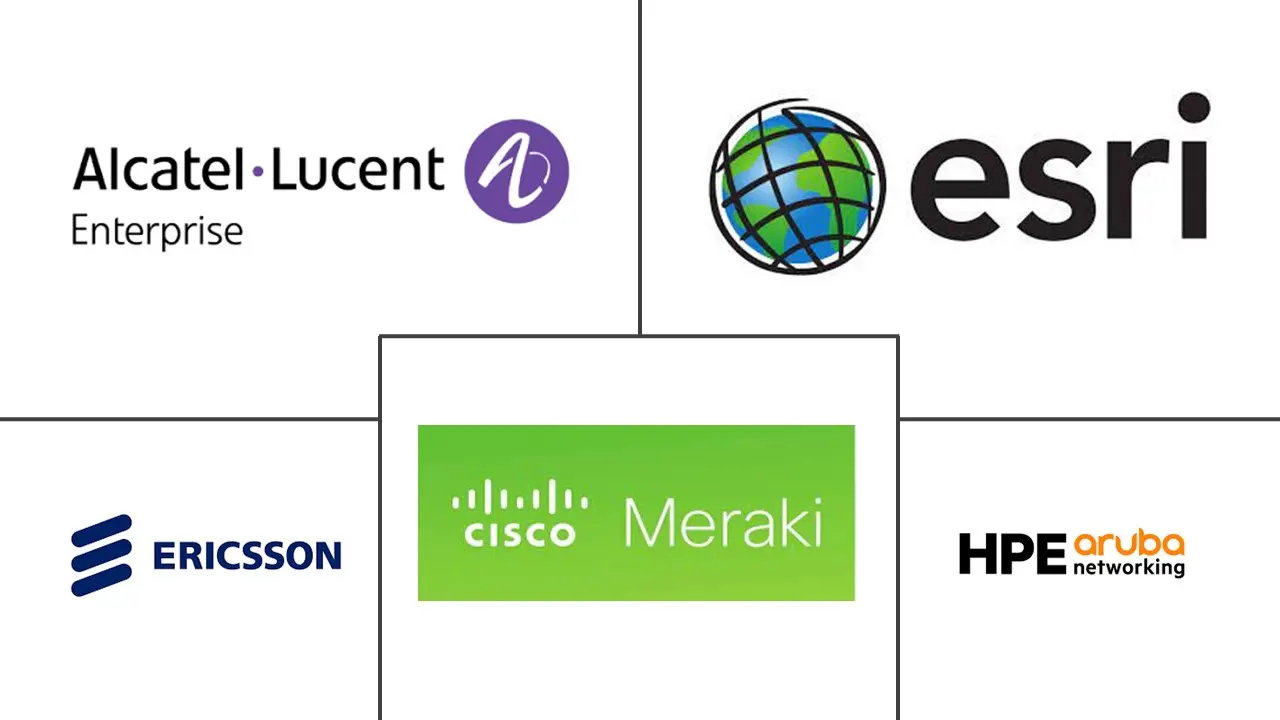Market Size of Nordics Location-Based Services Industry

| Study Period | 2019 - 2029 |
| Base Year For Estimation | 2023 |
| Forecast Data Period | 2024 - 2029 |
| Historical Data Period | 2019 - 2022 |
| CAGR (2024 - 2029) | 15.64 % |
| Market Concentration | Medium |
Major Players
*Disclaimer: Major Players sorted in no particular order |
Nordics Location-Based Services Market Analysis
The Nordics Location-Based Services Market is expected to register a CAGR of 15.64% during the forecast period.
Location-based services (LBS) have emerged significantly during the past few years. It is used for locating friends in an area, locating the nearest restaurant, or advertising sales to shoppers nearby. Location-based services give users access to relevant and up-to-date knowledge about their surroundings and allow businesses to update their customers regarding their orders.
- Location-based services require much high-resolution data for both government and commercial usage. A vast constellation of satellites is required to cater to the increasing demand for these services. LBS providers offer services that are tailored to the needs of users. Hence, the global positioning system (GPS) is crucial in finding the locations. GPS is a worldwide satellite navigational system formed by a constellation of 24 Earth-orbiting satellites. Moreover, the need for LBS to function appropriately in challenging urban landscapes, such as between high-rise buildings, is increasing the desirability of multi-GNSS solutions that can access the information of more constellations to compensate for the restricted satellite visibility.
- With the rising number of commercial vehicles across the region, the need to manage vehicles is also increasing with the evolving technology. According to ACEA, in the European Union, demand for new commercial vehicles climbed by 24.0% to reach 1,292,628 units. In this period, demand for new light commercial vehicles in the EU remained strong (+23.6%). Moreover, the telematic systems being incorporated in vehicles allow the exchange of information via the integration of the Internet, offering better fleet tracking. Telematic systems consist of communication systems, with internet service provided for getting vehicle locations. Telematic systems in transportation control the fuel cost with enabled engine diagnostics and maintenance for real-time vehicle tracking.
- Health service and information providers can react immediately to the changed location of a mobile user by conveying personalized, timely information and services for the user's new roaming region. With the help of indoor mapping and navigation products, patients can be assisted in making their way to and through any healthcare facility. Real-time information can be conveyed to the patients depending on where they are in the hospital, allowing them to make appointments on time and find the correct testing area. Patient tracking is essential for more vulnerable patients, such as people with Alzheimer's or younger children. Patients can be located directly in an emergency to deliver care faster and more efficiently.
- On the contrary, location-based services are revolutionizing a variety of businesses where resource efficiency is crucial. The positions of individuals may be tracked at all times, and LBS gives the visibility needed to keep people safe. As a result, data security and privacy become increasingly important for users as misuse may result in disastrous consequences. The frequency of data breaches has risen considerably in recent years due to various applications defying restrictions to gain access to a user's location without their authorization. Google plans to implement a recent policy change requiring all app designers to undergo an authorization process before their apps collect the user's location information while running in the background.
Nordics Location-Based Services Industry Segmentation
Location-based services (LBSs) are computer or mobile applications that provide information based on the device's location and the user, primarily through mobile portable devices, such as smartphones and mobile networks. The precision of the location services primarily depends on the hardware and software used in the mobile communication system, along with the positioning server.
The Nordics location-based services market is segmented by component (hardware, software, and services), location (indoor and outdoor), application (mapping and navigation, business intelligence and analytics, location-based advertising, social networking, and entertainment), and end user (transportation and logistics, IT and telecom, healthcare, government, BFSI, hospitality, and manufacturing). The market sizes and forecasts are provided in terms of value (USD) for all the segments mentioned above.
| By Component | |
| Hardware | |
| Software | |
| Services |
| By Location | |
| Indoor | |
| Outdoor |
| By Application | |
| Mapping and Navigation | |
| Business Intelligence and Analytics | |
| Location-based Advertising | |
| Social Networking and Entertainment | |
| Other Applications |
| By End User | |
| Transportation and Logistics | |
| IT and Telecom | |
| Healthcare | |
| Government | |
| BFSI | |
| Hospitality | |
| Manufacturing | |
| Other End Users |
Nordics Location-Based Services Market Size Summary
The Nordics location-based services (LBS) market is experiencing significant growth, driven by the increasing demand for high-resolution data and the integration of advanced technologies such as GPS and multi-GNSS solutions. These services are becoming integral in various sectors, including transportation, healthcare, and retail, by providing real-time information and enhancing operational efficiency. The market is characterized by the rising adoption of telematics in commercial vehicles, which facilitates better fleet management and tracking. Additionally, the proliferation of indoor positioning technologies, such as Bluetooth Low Energy beacons and Wi-Fi, is enabling precise location tracking within large facilities, further expanding the scope of LBS applications.
Key players in the Nordics LBS market, including ALE International, Cisco Systems Inc., and Ericsson Inc., are actively engaging in strategic partnerships and product development to enhance their market presence. The market is witnessing innovations such as the integration of Google Maps Platform by Mercedes-Benz and the collaboration between Mapbox and Toyota Motor Europe, which are set to revolutionize the automotive industry with advanced navigation and real-time information capabilities. Despite the challenges related to data privacy and indoor positioning accuracy, the market is poised for substantial growth, supported by ongoing technological advancements and increasing smartphone penetration.
Nordics Location-Based Services Market Size - Table of Contents
-
1. MARKET INSIGHTS
-
1.1 Market Overview
-
1.2 Industry Attractiveness - Porter's Five Forces Analysis
-
1.2.1 Bargaining Power of Buyers
-
1.2.2 Bargaining Power of Suppliers
-
1.2.3 Threat of New Entrants
-
1.2.4 Threat of Substitutes
-
1.2.5 Intensity of Competitive Rivalry
-
-
1.3 Industry Value Chain Analysis
-
1.4 Assessment of the Impact of COVID-19 on the Market
-
-
2. MARKET SEGMENTATION
-
2.1 By Component
-
2.1.1 Hardware
-
2.1.2 Software
-
2.1.3 Services
-
-
2.2 By Location
-
2.2.1 Indoor
-
2.2.2 Outdoor
-
-
2.3 By Application
-
2.3.1 Mapping and Navigation
-
2.3.2 Business Intelligence and Analytics
-
2.3.3 Location-based Advertising
-
2.3.4 Social Networking and Entertainment
-
2.3.5 Other Applications
-
-
2.4 By End User
-
2.4.1 Transportation and Logistics
-
2.4.2 IT and Telecom
-
2.4.3 Healthcare
-
2.4.4 Government
-
2.4.5 BFSI
-
2.4.6 Hospitality
-
2.4.7 Manufacturing
-
2.4.8 Other End Users
-
-
Nordics Location-Based Services Market Size FAQs
What is the current Nordics Location-Based Services Market size?
The Nordics Location-Based Services Market is projected to register a CAGR of 15.64% during the forecast period (2024-2029)
Who are the key players in Nordics Location-Based Services Market?
ALE International (Nokia Corporation), Cisco Systems Inc. (Cisco Meraki), Ericsson Inc, Esri Inc. and Aruba Networks (HPE development LP) are the major companies operating in the Nordics Location-Based Services Market.

